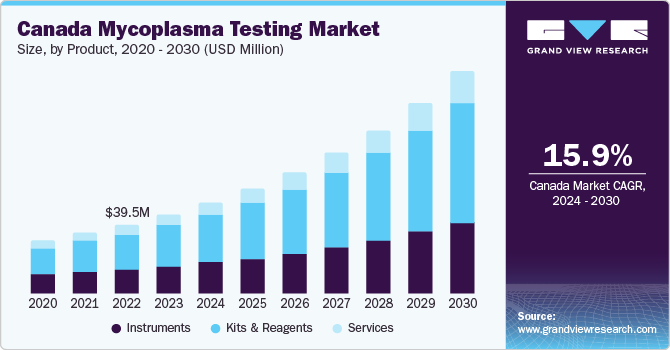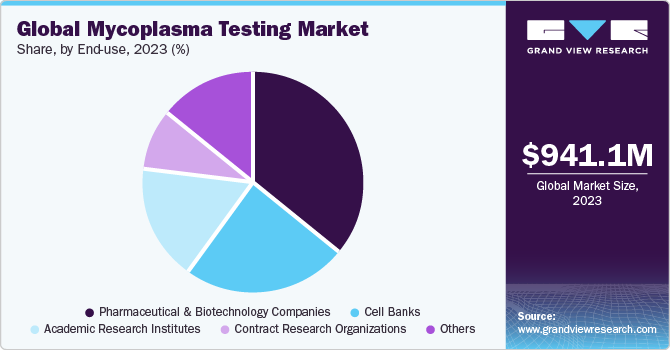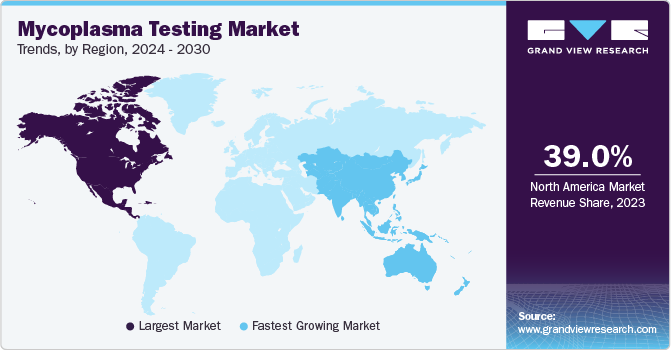- Home
- »
- Clinical Diagnostics
- »
-
Mycoplasma Testing Market Size, Share, Growth Report 2030GVR Report cover
![Mycoplasma Testing Market Size, Share & Trends Report]()
Mycoplasma Testing Market Size, Share & Trends Analysis By Product (Instruments, Kits & Reagents), By Technology (PCR, ELISA, Direct Assay, Microbial Culture), By Application, By End-use, By Region, And Segment Forecasts, 2024 - 2030
- Report ID: GVR-1-68038-897-8
- Number of Pages: 120
- Format: Electronic (PDF)
- Historical Range: 2018 - 2022
- Industry: Healthcare
Mycoplasma Testing Market Size & Trends
The global mycoplasma testing market size was estimated at USD 941.1 million in 2023 and is expected to grow at a compound annual growth rate (CAGR) of 13.58% from 2024 to 2030. Rising R&D investments are one of the key factors influencing the market growth positively. Furthermore, the need for mycoplasma tests is driven by the adoption of new technologies for drug research and development and advancements in cell culture technology. For instance, in February 2023, SwiftDx introduced a novel mycoplasma detection kit. The newly launched SwiftDx Mycoplasma Detection Kit provides a faster and more convenient solution for detecting mycoplasma contamination through a lateral flow test.

The biopharmaceutical and related markets have not been significantly impacted by the COVID-19 pandemic when compared to other industries. According to a study published in May 2022, there is a correlation between mycoplasma testing numbers and COVID-19-related Non-Pharmaceutical Interventions (NPIs). This study analyzed the incidence of M. pneumonia after the implementation of COVID-19 NPIs. This survey showed that there has been a decrease in M. pneumonia detection during the pandemic and a reduction was observed globally between March 2020 and March 2021. The reduction is majorly due to restricted transmission of M. pneumonia, resulting in a significant reduction in M. pneumonia infections across the globe.
As a result of innovative approaches and substantial investments by operating players, mycoplasma testing is witnessing increasing attention. For instance, seven of the top 10 best-selling drugs in early 2020 were biologics. It is representative of the emergence of biologics in the global market. Cell lines play a crucial role in production of various biologic products, such as monoclonal antibodies, viral vaccines, and cytokines, which are used for medicinal or therapeutic purposes. Mycoplasma strains affect metabolism, physiology, and gene expression of cell lines extensively. Thus, it is necessary to check mycoplasma contamination in biopharmaceutical production. Microbiological monitoring is required throughout the manufacturing process. Thus, increasing the requirement for mycoplasma testing in biopharmaceutical production workflow has created lucrative opportunities for product and service providers.
Increasing R&D investments by key companies and rising research costs are likely to encourage firms to adopt highly efficient mycoplasma testing tools. For instance, Bristol-Myers Squibb started investing in the production of investigational medicines to support clinical trials. In addition, with the advent of biosimilars, because of lucrative R&D investment, it has become imperative to conduct safety testing to ensure that a product meets the standards to ensure efficacy, safety, and overall public health. In December 2022, Merck KGaA invested over USD 427.3 million (EUR 399 million) in its R&D facilities of life science business. The investment provides more resources for companies to develop new and innovative testing technologies, including mycoplasma. It led to the development of more accurate, sensitive, and affordable tests. It is expected to improve the penetration of mycoplasma testing tools.
Rising government initiatives to support biotechnology and pharmaceutical companies are driving the market. The FDA proposed to exclude a test for detecting mycoplasma within in vitro living cell cultures, as it can help identify only a single test method. Such changes in biologics regulations are expected to improve sensitivity and specificity in mycoplasma detection tests, evolving new technologies in the industry. This change is expected to create opportunities for major players in the market space. According to Saudi Arabia’s 2030 Vision, its government is promoting growth of pharmaceutical industries as only 30% of its medication requirements are produced locally. Empire State Development funded USD 300,000 to Bionique to help upgrade lab equipment in its Testing Laboratories. The company’s project worth USD 1.5 million includes development of advanced technology for mycoplasma testing in labs.
Market Dynamics
There is a growing demand for rapid mycoplasma tests that can provide results within minutes or hours. It is crucial for clinical settings where quick diagnosis is critical. Mycoplasma testing platforms are becoming smaller and more portable. It makes them more convenient and easier to use in various settings. These platforms are increasingly integrated with laboratory information systems. It allows for the automated transfer of test results to the patient's medical record. POC mycoplasma tests are developed that can be used in non-laboratory settings, such as doctor's offices and clinics.
Regulatory agencies worldwide have implemented guidelines and regulations to ensure the safety and efficacy of biopharmaceutical products. These regulations mandate the testing of biopharmaceutical products for mycoplasma contamination. Regulatory agencies are working together to harmonize standards for these tests. It is easier for companies to comply with regulations in different countries.
Raw materials used in cell culture, such as media and reagents, play a crucial role in supporting the growth of cells for mycoplasma testing. Quality control of these materials is essential to prevent contamination. Antibodies and other detection reagents are used in various immunoassays for mycoplasma detection. High-quality antibodies and detection reagents are integral to the accuracy and sensitivity of these tests. Additionally, data analysis software is crucial in mycoplasma testing. These factors are expected to support market growth.
Product Insights
The kits and reagents segment captured the highest revenue share of 51.16% in 2023 due to the high demand for these products in mycoplasma detection and their high cost. To provide sensitive and accurate results, various market players have developed mycoplasma detection kits catering specifically to the needs of researchers and biologic manufacturers. One such kit has been developed by R&D Systems, detects approximately eight mycoplasma species commonly known to cause more than 95% of contaminations, using high throughput screening.
Mycoplasma can be detected by verifying bands of DNA fragments using electrophoresis, which is used by PCR assays that do not require the preparation of labeled probes. For instance, Takara Bio Inc. developed a PCR mycoplasma detection set that does not allow further amplification of DNA originating from other sources, such as cultured cells majorly affecting detection results. By using this product, gene sequencing amplification enhances the specificity and sensitivity of detection.
Technology Insights
The PCR segment dominated the market with a revenue share of 32.68% in 2023 and exhibited the fastest growth rate during the projected period. Ease of procedure and rapid detection are some of the key advantages offered by this method. Contamination in cell lines is one of the biggest concerns for researchers and biologic manufacturers. PCR technology has increasingly been used for routine cell line maintenance. These detection methods are proven to provide sensitive and rapid results, increasing the demand for these products in research laboratories. For instance, the Merck KGaA-developed LookOut Mycoplasma PCR Detection Kit makes it easier to detect contamination with Ureaplasma, Mycoplasma, and Acholeplasma in cell-derived biologicals and cell culture lines.
The ELISA technology segment held the second largest market share during the forecast period as it facilitates easy detection using labeled probes or antibodies for mycoplasma detection. In some instances, PCR and ELISA tests are combined to form PCR-ELISA, a photometric enzyme-based immunoassay that facilitates the detection of PCR-amplified mycoplasma DNA in samples. Functional advantages, cost-effectiveness, and ability to detect a wide range of strains are a few factors propelling segment growth during the forecast period.
Application Insights
The cell line testing segment accounted for the largest share of 41.65% in 2023, as well as the fastest growth rate throughout the forecast period, owing to the increase in research projects done in the field of cell culture. There is a high need for cell line testing in mycoplasma detection, facilitating segment growth and leading to rising R&D initiatives and investment. For instance, the federal funding agency in Canada for health research, the Canadian Institutes of Health Research (CIHR), has supported many health researchers in Canada with around USD 981 million in investments. The National Research Council’s Industrial Research and Assistance Program (NRC-IRAP) offers technical support to several Canadian life science companies, including small and medium-scale, involved in product development and innovation.
The end of production cells testing segment held the second-largest share of the market in 2023. The end of product testing includes stability and contamination testing. These ensure product safety by checking genetic stability of recombinant cells after the production process. In addition, it validates the production system and ensures that the system has no contamination issues. The importance of end of product cells testing in authenticating stability and contamination-free nature of a product is expected to act as a driver for this segment.
End-use Insights
The pharmaceutical and biotechnology companies segment received the highest revenue shares of 35.56% in 2023 and the fastest CAGR throughout the forecast period. These firms have made significant investments in R&D efforts, which have fostered advancements in the field of drug development research. These businesses carry out quality tests on raw materials to manage biological safety. Furthermore, the prevalence of disorders like rheumatoid arthritis and psoriasis is rising, which is contributing to the growth of the biopharmaceutical industry.

Due to the expanding research services offered by these firms, contract research organizations (CROs) are predicted to grow profitably over the projected period. CROs deliver services like biologic assay development, commercialization, biopharmaceutical development, and pharmacovigilance. They require the use of tests, such as mycoplasma testing, which are needed to maintain the sterility of cultures used in preclinical research and biopharmaceutical development. These facilities ensure the quality of the outsourced testing services. Increase in number of CROs is expected to contribute to the segment growth.
Regional Insights
North America dominated the market and accounted for a revenue share of 39.04% in 2023. High incidence of respiratory disorders and growing investment in biotechnology by leading companies, owing to its increased adoption in cancer research and development of new biologics, vaccines, & drugs, are factors responsible for high market share. Moreover, organizations such as the FDA and the U.S. Department of Health and Human Services, in collaboration with Centers for Disease Control and Prevention & National Institutes of Health, consistently strive to improve biological & microbiological safety testing standards for biomedical laboratories through formulation & enforcement of stringent regulatory guidelines.

Asia Pacific is estimated to grow at the fastest CAGR over the forecasted period. Regulatory policies imposed by healthcare organizations favoring improvements in biosafety quality are likely to surge growth opportunities in the future. The National Biotechnology Development Strategy—led by the government to establish itself as a leading manufacturing entity—is anticipated to positively affect the use of mycoplasma tests, owing to maintenance of higher product safety standards and better infrastructure. In addition, these changes are anticipated to impart long-term benefits to human health and ensure sustainable industrial growth of the biologics and pharmaceutical industry. The presence of biological safety guidelines specific to the research segments, such as recombinant DNA research and cell culture, indicate further growth potential.
Key Companies & Market Share Insights
Key players in this market are implementing various strategies, including partnerships through mergers and acquisitions, geographical expansion, and strategic collaborations to expand their market presence.
-
In April 2023,Agathos Biologics announced its offering of analytical testing services to life science researchers. Agathos exclusively utilizes QIAcuity instrumentation and assays developed by QIAGEN. Furthermore, Agathos has collaborated with QIAGEN to conduct testing and validation for mycoplasma and recombinant adeno-associated viral vector (rAAV) assays.
-
In February 2023, Thermo Fisher Scientific, Inc. launched the TrueMark STI Select Panel. It is used to detect the four most common sexually transmitted infectious pathogens with one panel. The panel uses polymerase chain reaction to detect Chlamydia trachomatis and Mycoplasma genitalium.
Key Mycoplasma Testing Companies:
- Thermo Fisher Scientific, Inc.
- Lonza Group AG
- Merck KGaA
- Charles River Laboratories International, Inc.
- PromoCell GmbH
- American Type Culture Collection
- Asahi Kasei Medical Co., Ltd
- Sartorius AG
- InvivoGen
- Eurofins Scientific
- (ATCC) American Type Culture Collection
Mycoplasma Testing Market Report Scope
Report Attribute
Details
Market size value in 2024
USD 1.05 billion
Revenue forecast in 2030
USD 2.26 billion
Growth rate
CAGR of 13.58% from 2024 to 2030
Base year for estimation
2023
Historical data
2018 - 2022
Forecast period
2024 - 2030
Report updated
January 2024
Quantitative units
Revenue in USD million/billion and CAGR from 2024 to 2030
Report coverage
Revenue forecast, company ranking, competitive landscape, growth factors, trends
Segments covered
Product, technology, application, end-use, region
Regional scope
North America; Europe; Asia Pacific; Latin America; Middle East & Africa
Country scope
U.S.; Canada; Germany; UK; France; Italy; Spain; Denmark; Sweden; Norway; Russia; China; Japan; India; South Korea; Australia; Singapore; Thailand; Brazil; Mexico; Argentina; South Africa; Saudi Arabia, UAE; Kuwait
Key companies profiled
Thermo Fisher Scientific, Inc.; Merck KGaA; Lonza Group AG; Charles River Laboratories International, Inc.; PromoCell GmbH; American Type Culture Collection; Asahi Kasei Medical Co. Ltd.; Sartorius AG; InvivoGen; Eurofins Scientific; (ATCC) American Type Culture Collection
Customization scope
Free report customization (equivalent up to 8 analyst’s working days) with purchase. Addition or alteration to country, regional & segment scope.
Pricing and purchase options
Avail customized purchase options to meet your exact research needs. Explore purchase options
Global Mycoplasma Testing Market Report Segmentation
This report forecasts revenue growth at global, regional, and country levels and provides an analysis of the latest trends and opportunities in each of the sub-segments from 2018 to 2030. For this study, Grand View Research has segmented the global mycoplasma testing market report based on product, technology, application, end-use, and region:
-
Product Outlook (Revenue, USD Million, 2018 - 2030)
-
Instruments
-
Kits & Reagents
-
PCR Assays
-
Nucleic Acid Detection Kits
-
Stains
-
Elimination Kits
-
Standards & Controls
-
Others
-
-
Services
-
-
Technology Outlook (Revenue, USD Million, 2018 - 2030)
-
PCR
-
ELISA
-
Direct Assay
-
Indirect Assay
-
Microbial Culture Techniques
-
Enzymatic Methods
-
-
Application Outlook (Revenue, USD Million, 2018 - 2030)
-
Cell Line Testing
-
Virus Testing
-
End of Production Cells Testing
-
Others
-
-
End-use Outlook (Revenue, USD Million, 2018 - 2030)
-
Academic Research Institutes
-
Cell Banks
-
Contract Research Organizations
-
Pharmaceutical & Biotechnology Companies
-
Others
-
-
Regional Outlook (Revenue, USD Million, 2018 - 2030)
-
North America
-
U.S.
-
Canada
-
-
Europe
-
Germany
-
UK
-
Spain
-
France
-
Italy
-
Denmark
-
Sweden
-
Norway
-
Russia
-
-
Asia Pacific
-
Japan
-
China
-
India
-
South Korea
-
Thailand
-
Australia
-
Singapore
-
-
Latin America
-
Brazil
-
Mexico
-
Argentina
-
-
MEA
-
South Africa
-
Saudi Arabia
-
UAE
-
Kuwait
-
-
Frequently Asked Questions About This Report
b. The global mycoplasma testing market size was estimated at USD 941.1 million in 2023 and is expected to reach USD 1.05 billion in 2024.
b. The global mycoplasma testing market is expected to grow at a compound annual growth rate of 13.58% from 2024 to 2030 to reach USD 2.26 billion by 2030.
b. North America dominated the mycoplasma testing market with a share of 39.04% in 2023. This is attributable to rising healthcare spending and investments by the U.S. government to promote research-based activities in biopharmaceutical industries.
b. Some key players operating in the mycoplasma testing market include Bionique Testing Laboratories, Inc.; Lonza Group Ltd.; Merck KGaA; PromoCell GmbH; ATCC (American Type Culture Collection); Biological Industries Israel Beit Haemek Ltd.; Charles River Laboratories International, Inc.; Thermo Fisher Scientific; and InvivoGen.
b. Key factors that are driving the mycoplasma testing market growth include increasing investments in R&D activities, the rising introduction of novel technologies by key players, and a rise in cell culture contamination.
Share this report with your colleague or friend.
![gvr icn]()
NEED A CUSTOM REPORT?
We can customize every report - free of charge - including purchasing stand-alone sections or country-level reports, as well as offer affordable discounts for start-ups & universities. Contact us now
![Certified Icon]()
We are GDPR and CCPA compliant! Your transaction & personal information is safe and secure. For more details, please read our privacy policy.
We are committed towards customer satisfaction, and quality service.
"The quality of research they have done for us has been excellent."





